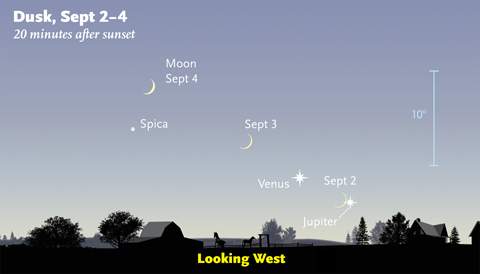Early evening features Mars and Saturn toward south, but keep an eye out for brilliant Venus climbing up from the west during twilight.
In this month's astronomy podcast, you'll learn about September's equinox, which marks the celestial end of summer and the beginning of autumn in the Northern Hemisphere. This year it occurs on the 22nd at 10:21 a.m. Eastern Daylight Time. At that moment the Sun shines directly overhead as seen from the equator.
Another celestial event is associated with this equinox: the Harvest Moon. Traditionally, it’s the name assigned to the full Moon that falls closest to the autumnal equinox, and in 2016 it falls on the night of September 16th. The Harvest Moon gets this name because around that date it never really gets dark between sunset and moonrise for several successive evenings, a boon to farmers working late to harvest their crops.

Sky & Telescope diagram
As darkness falls, look for the planets Mars and Saturn in the southwest. Over in the west, use the Moon's thin, rounded crescent on the 3rd or 4th to point to its lower right, very close to the horizon, to spot bright Venus glowing in the twilight. More challenging is finding Jupiter, to the lower right of Venus.
Meanwhile, look nearly overhead to spot the three widely-separated stars of the Summer Triangle. Vega is the one farthest west, Deneb is toward northeast, and Altair is farthest south. Watch week by week as this trio gradually migrates toward the western horizon.
For more skywatching tips — including how to find Draco, the Dragon, and the lovely Corona Borealis (Northern Crown) of stars — listen to or download our monthly astronomy podcast below.
Podcast: Play in new window | Download
Subscribe: Apple Podcasts | Google Podcasts | Spotify | Email | RSS | More
 1
1
Comments
Graham-Wolf
September 11, 2016 at 9:54 pm
The first fortnight of September has been quite a naked eye delight:- as you've predicted it, Kelly. All those planets and bright stars teaming up in several most interesting conjunctional formations. It's truly one of those times when you can just leave the 'scope in the shed, simply look up into the twilight with the naked eye, and go.... Mmmmmmmm. Just like our ancestors did so many centuries ago! Regards from NZ. Graham W. Wolf.
You must be logged in to post a comment.
You must be logged in to post a comment.